adriaticnature has had plans to continue conversations with an excellent angler, who owns one of the best European fishing stores Maguro Pro Shop, located in Zagreb (Croatia), Sasha Rakar for a long time.
The previous conversation was devoted to vertical jigging and catching large amberjacks and groupers in the Adriatic Sea. In this article, adriaticnature decided to ask Sasha about fishing in the Adriatic with lures using a technique called “rubber jigging”. And not only about it.
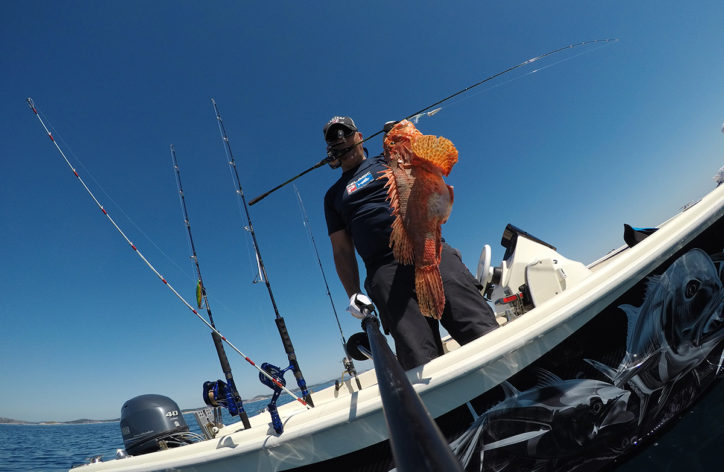
(Sasha Rakar and red scorpionfish caught with an inchiku. Photo © Saša Rakar)
Despite the fact that the technique is called “rubber jigging”, the lures, which will be discussed further, are made not only of rubber. They are divided into several types. Manufacturers often add the word “jig”:
Madai is a lure equipped with a large painted “head-sinker” made of heavy metal, which has an extension in the form of soft plastic tentacle-threads called “skirt” and “ties” (wider soft plastic bands). The lure is equipped with two small hooks, which “hang” loose on rather long special thin “cords”, ending with sharp small hooks, the so-called “assist hooks”, with which metal jigs are equipped as well. As a result, the lure in the water either resembles a squid or imitates an unknown multi-colored “little animal”, doing something at the bottom.
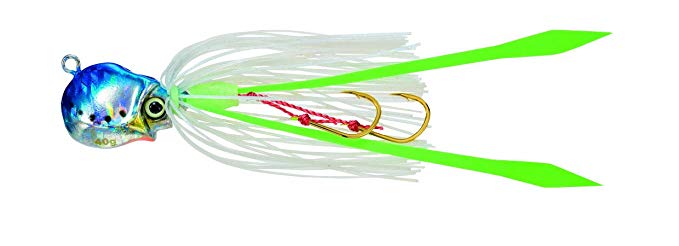
(Madai Yo Zuri Salty Rubber. Photo © geonldonline.com)
Kabura, or Tai-Kabura, or Tai-Rubber is similar to madai, but this name is often used to call lures with a round sinker-body and large eyes painted on the sides. Another distinguishing feature of kabura is that the “eye-sinker-body” is not tightly attached to the part where the soft plastic “skirt” (with the assist hooks hidden in it) is located, and it can slide along the cord, with which it is attached to the shock leader. Such models are called “sliders”.
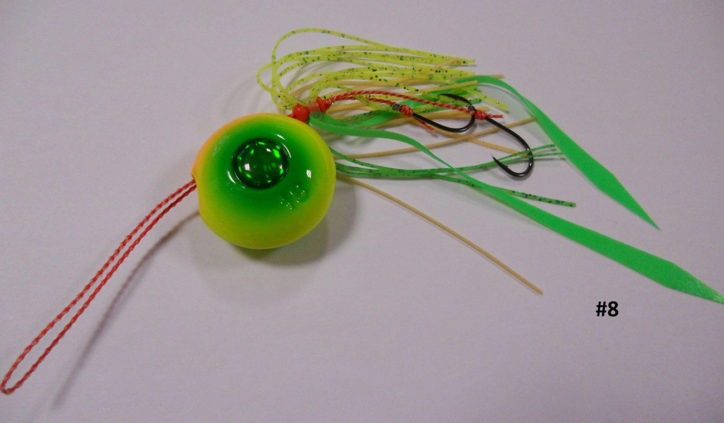
(Kabura Hayabusa Free Slide. Photo © skalaitzi.com)
Inchiku is different from madai and kabura in the shape of the sinker, which resembles either a small iron or a short thick ski, and sometimes it looks like a small fish. Moreover, there is a peculiar way of attaching hooks and a soft plastic component, which most often consists of a small soft plastic squid, with the assist hooks put through the hollow body on thin cords. More often, the cords with the attached sinker are located in the first third of the wide part of the body. Manufacturers “fit” the cords with faceted glass or plastic beads that additionally attract the attention of predators with their glitter.
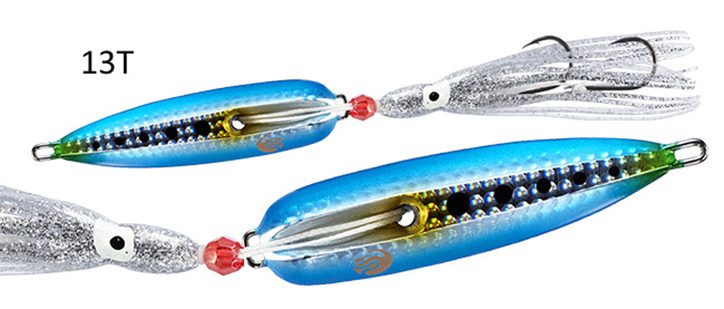
(Inchiku Shimano Bottom Ship II Jigs. Photo © tsourosmarine.gr)
These are the main types of lures with a “sinker-head”, which are used in the “rubber jigging” technique. However, for example, kabura can be specially equipped for using buzzes of animal origin – fish, squid, cuttlefish and so on.
There is a special lure called tenya, which is quite often a sinker in the form of a bell filled with metal. It generates oscillations when it falls to the bottom. A hook, on which any buzz of animal origin is put (most often a shrimp), is attached to the “bell” or to the “head” of a different shape. It is usually equipped with additional “assist hooks”. But tenya can be used with soft plastic lures as well.
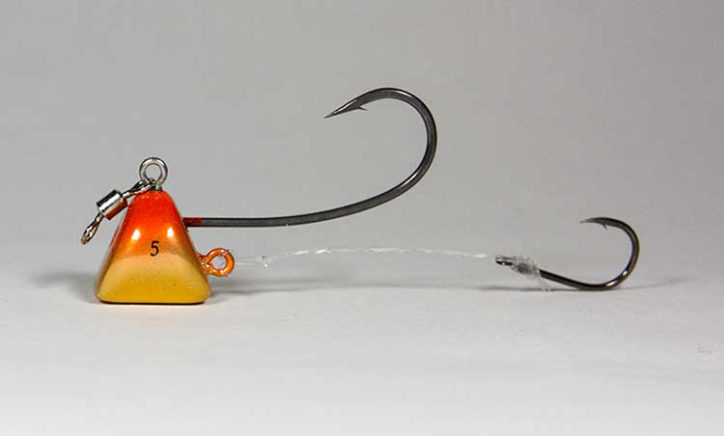
(Daiwa Kouga Tai Tenya SS. Photo © sansui1902.jp)
To sum up the long-running introduction – fishing with lures using the “rubber jigging” technique stands somewhere alongside fishing with lures of animal origin and is somewhat similar to the “slow jigging” technique. adriaticnature decided to talk with Sasha Rakar about the nuances of “rubber jigging”.
– Hello, Sasha! We discussed the questions, so let’s not break your answers with them and publish it all as a single text.
Greetings to adriaticnature readers!
You know, I catch fish using all sports techniques, and I like each of them. I enjoy trolling marlins with sight in the oceans, catching our bluefin tunas in the Adriatic, and catching sea basses from the shore with a spinning rod. Jigging is somewhere in the middle, and it’s been my favorite one for the last seven years, or maybe more, it’s hard to tell.
Thanks to my work in Maguro Pro Shop and the desire to know as much as possible about different fishing techniques, I was lucky to meet and communicate with the best anglers, real professionals in various techniques, including Pony Liu, the founder of Jigging Master, Sensei Sato, whom I met in Japan at the meeting with colleagues from Sea Floor Control, and Markos Vidalis, one of the best, and perhaps the best “shore jigger”.
Every successful fisherman improves his technique by using the experience and knowledge of other people. Thus, I’m always happy to learn something new and to implement these new things, if I get such an opportunity.
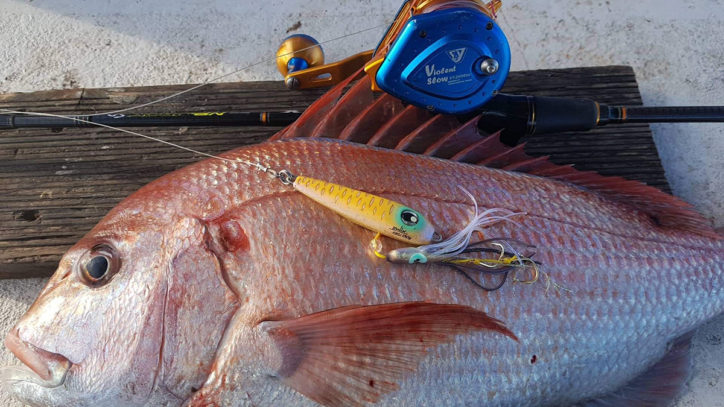
(Pink dentex caught with an inchiku. Photo © Saša Rakar)
My approach to choosing tackle is very simple – based on my experience, I know that the sea requires quality and doesn’t forgive bad tackle. So, when choosing tackle, I always give preference to products of trusted brands and buy a rod or reel produced by the company, for which it is the main product, and at almost the same price compared to other manufacturers. The quality of such a tackle is 2-3 times better.
I’ll say a few words about my rating of tackle as regards technique. If we’re talking about vertical or slow jigging, the tackle produced by Jigging Master is the only option. Light Jigging and Spin Fishing – Major Craft. As for “shore-jigging”, the range of rods for “heavy” artillery in the market is quite wide, and almost all serious manufacturers have something to offer. Judging by the sales of our store, I would say that Major Craft is the market leader, however, watching the success of Markos Vidalis (he catches fish with Zenaq rods), I must admit that this company is the leader in this fishing area.
Of course, my opinion is subjective. It is based on my experience with the brands I work with. And I respect any other opinion about choosing the tackle, except for some manufacturers, which are not worth mentioning in our conversation. Since we talked about “clean” vertical jigging some time ago, I will be glad to talk about my experience with the rubber jigging technique.

(Pink dentex and John Dory caught with the rubber jigging technique. Photo © Saša Rakar)
I’ll start with tenya. In my opinion, it’s a great lure, extremely efficient, very popular in Japan. And, probably, no brand doesn’t have its versions and models.
Tenya belongs to the class of lures designed for fishing using ultralight and light jigging techniques, and that’s why their heavy versions are not produced. When you use tenya, it’s important to understand that this lure is designed to catch “Fall Game” – fish attack the lure while it’s falling.
If you want tenya to fall into the sea depths efficiently and easily, it is recommended to use lightweight jigging sets and PE braids with a thickness of #0.6 – #0.8 according to the Japanese classification. In my opinion, the braid should freely come off the reel and shouldn’t restrain it during its free fall to the bottom.
I guess that because of a misunderstanding of the basics of fishing, this lure is the least popular among fishermen of the Adriatic, and the Mediterranean Sea as a whole. They catch with dead fish and pieces of the latter using tenya. It is simply destined to catch predators. I believe that it will become popular in our countries.
Our anglers still can’t get used to the fact that each technique requires its approach and specialized tackle, therefore they have no experience in fishing with tenya since it’s impossible to fish with this lure using “heavy” tackle that is already quite familiar to us.
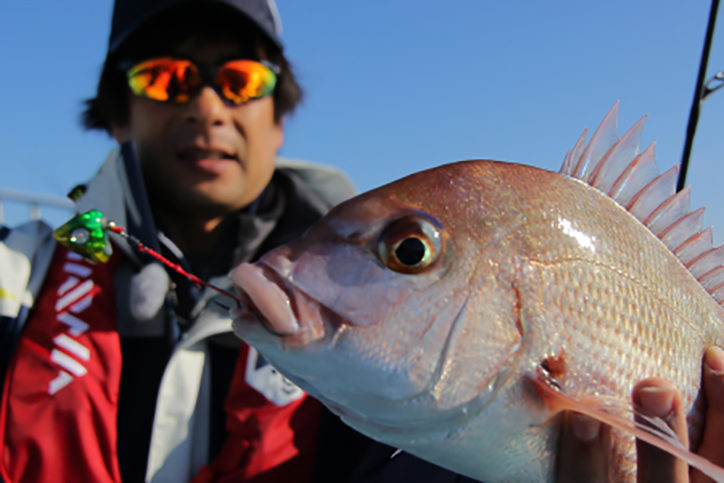
(Porgy caught with a tenya. Photo © fishingbuddy.com.sg)
Kabura. It is another lure that is very popular in most maritime countries. And again, it’s not popular in our countries. Although, of course, it’s a little more popular than tenya. But its popularity is far from the one it deserves thanks to its catch efficiency.
I like both the “sliders” and the “classic” types of kabura. Nowadays, the latter is very rarely produced. Therefore, they are rarely found on the market.
The technique of fishing with them is very simple. The lure rises vertically from the bottom to the surface at a steady pace. According to some rules, the speed of rising of the lure can change only occasionally. “Jerks” and the “slow” technique are not designed for kabura fishing and they are inefficient.
Anglers starting to use kabura often begin to experiment and use more powerful and heavier hooks, but I think this kills the conceived game of the lure and its “skirt”, which triggers the predator to bite. The arguments of these anglers come down to the fact that when they use the original hooks, a lot of fish get off the hook, and there is a very low Hook-Up Ratio.

(Australasian snapper caught with a kabura. Photo © nzfishingworld.co.nz)
The “rubber jigging” technique largely depends on the rods, which are very “soft”. The manufacturers make such rods so that angler could feel the lightest bite signal and the weak blow of predators, who grab the lure by the moving skirt with the hooks hidden in it. And after the bite, you begin to reel the fish that was caught with the lure using a multiplier reel – most rods designed for the rubber jigging technique are made with an amount for the “multiplier”. The rod works with the resisting fish, restraining its jerks and attempts to escape, preventing the predator from getting off the hook. And playing is performed using a reel.
If someone uses the wrong rod and reel for this technique and has problems with fish getting off, false bites, and so on, they should probably change something in their fishing kits, but this issue should be considered individually.
One might say, I always fish “as the school book says”, as a certain technique initially requires. And then I understand that I did everything right, and I don’t say that lures and techniques are inefficient because of my ignorance.

(Amberjack caught with a kabura. Photo © campandtackle.co.nz)
Nowadays, new kabura made by Major Craft (“Tainomi”), X Paragon (“Zulu”), Nikko Kasei and so on produce modified “tenya-like” sinker-heads that have a center of gravity that enables kabura to sink to the bottom, similar to tenya, making them much more efficient than standard kabura produced by low-cost brands.
Speaking about the segment of modern and advanced “rubber jigging” and accessories for it, I can’t but mention the octopus skirts and other Nikko Kassei accessories for tuning your jig lures. Nikko Kasei is a Japanese manufacturer and inventor of the very best soft plastic “skirts” on the market today. Predatory fish have to get interested in the way the lures look, “taste” and smell. So, Nikko developed soft plastic lures that look like animal buzzes due to their buoyancy, density, like that of living buzz flesh, and smell that all of their soft plastic lures are saturated with. When fish touches the Nikko lure, it has no doubt and immediately swallows it with greed entirely.

(Red scorpionfish caught with a kabura and Nikko’s silicone octopus. Photo © nzfishingworld.co.nz)
Adding Nikko Kasei octopus skirts, squid strips, and scented balls to your “rubber jigging” lures is all you need to succeed in these techniques.
Inchiku, as a lure for “rubber jigging”, is probably the most popular and “successful” in our area. It catches fish in any conditions and at any depths. Both bottom predators and those looking for their prey in other water layers can’t help but attack inchiku while it’s being lifted to the boat. The lure is pulled by its narrower part, imitating the movements of the squid.
I’ve been using inchiku for many years. In my opinion, the most efficient model is Kiku produced by Molix, with which many anglers made their dreams come true. The lure has all the qualities that are necessary for a perfect inchiku, including a well-balanced center of gravity in the lower part of the sinker-head body, a large painted “eye” on it, a fluorescent “belly” and an amazing soft lure octopus-skirt. I’ve already expressed my opinion about replacing hooks with larger ones before, so replacing them is an individual decision. Replacing a soft lure octopus with Nikko Octopus Skirt can make Kiku a lethal weapon.

(John Dory caught with an inchiku. Photo © Saša Rakar)
Some of our customers use Nikko skirts with a lead sinker, which they mount in the head of the skirt along with assist hooks. These soft plastic lures are virtually indestructible, and they can be stretched to 5 times the size of their original length. You can put a sinker weighing 200-300 grams in some models.
Inchiku works perfectly on the stream, as it catches better when it is at a certain angle, diagonally to the angler, rather than vertically. You can experiment with the lure retrieve – work with “jerks”, quick pulling – it will catch anyway. Quite a few brands are producing these lures on our market. I tried fishing only with Molix Kiku, Megabass Volt, Hart 30/60 and Seaspin Suchadu. The latter model, weighing 200 grams, is exceptionally efficient for catching porgies at great depths with quick “pulling up” of the lure.
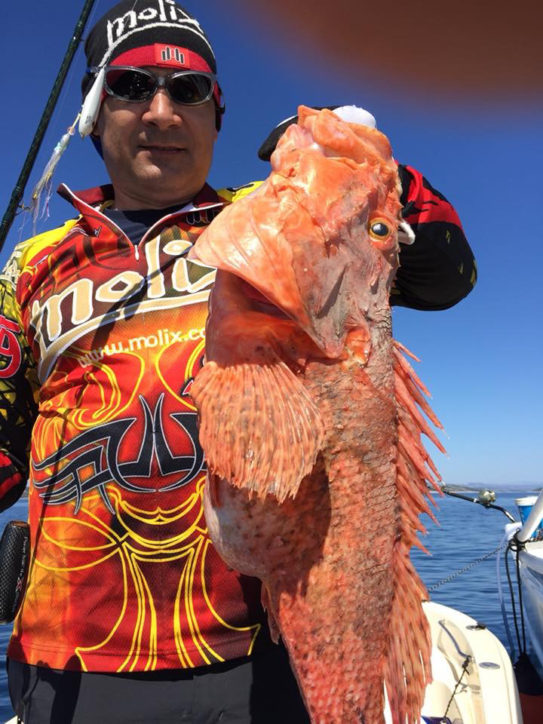
(Red scorpionfish caught with an inchiku. Photo © Saša Rakar)
And finally, I’d like to say a few words about the lures of X Paragon, Live, and Dead systems.
About two years ago, I began to fish with X Paragon lures at the urging of my Greek friend Tasos Polizois, who promoted the traditional Greek system of catching dentexes, porgies, amberjacks, groupers, called Zoka.
Initially, this method was intended to lower the live or dead buzz to the bottom as quickly as possible on microlocations at great depths. In such places and at such depths, classical trolling with a lively buzz and heavy sinker, as well as other methods weren’t efficient.
X Paragon Zoka Ball is a perfect lure for fishing at great depths, allowing you to get serious catches in a very simple way and without much effort. The Zoka Ball system has a fixed hook and resembles a large jig head, to which you can attach additional assist hooks. You put a live or dead buzz using them and lower Zoka to the desired depth. With slight movements, just touching the bottom a little, if you catch with a dead buzz in the lower water layer, you can add “life” to your lure, and if the predator is nearby, it won’t be able to resist attacking. And thanks to the powerful Zoka hooks and the assist hooks you added, the fish is unlikely to get off the hook.
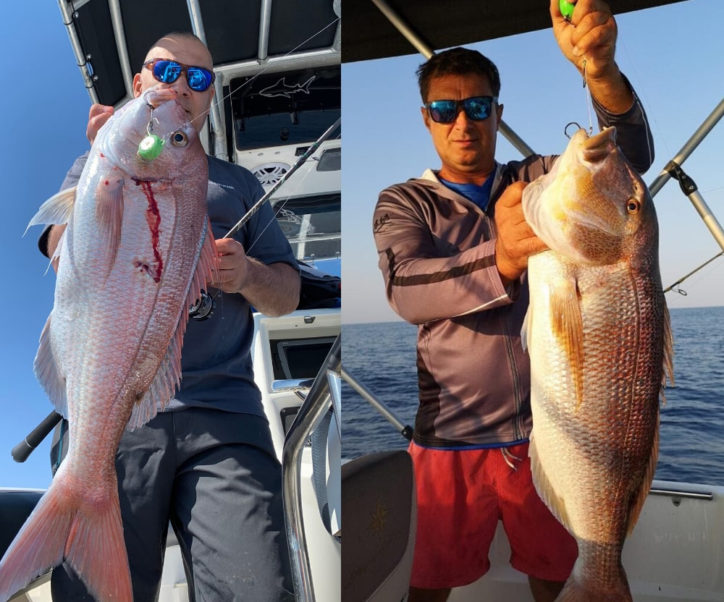
(Pink dentex and common dentex caught with “Zoka Ball”. Photo © Saša Rakar)
Why X Paragon? First of all, because X Paragon was the first, and also because of deep respect for the innovative fisherman who offered us such a wonderful way of fishing. I don’t need the lure replicas. Secondly, these lures are of extremely high quality. They are covered with plastic with Stardust Glow plasticizer and are almost eternal. Moreover, Stardust Glow has one of the most powerful glow effects I’ve ever seen. The color of the lure is both important and unimportant. At the depths where we use Zoka, any color gets a yellow hue, and the difference depends on the power of the “glow” effect, which can be adjusted. For example, yellow Zoka has the brightest glow, orange – a little weaker, then green, pink and blue go in order.
New models of natural colors are excellent as well. They are rather efficient. I caught several spiny lobsters and one lobster when I used the Zoka Ball Natural system with dead squids, sardines and Inove special elastic thread.
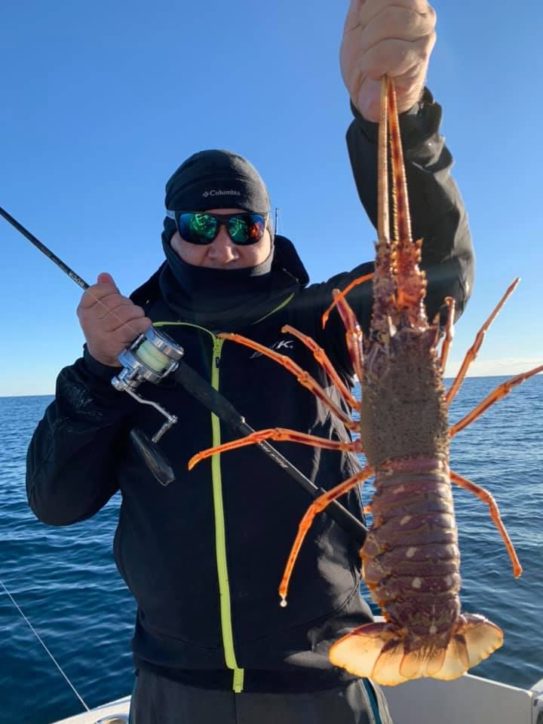
(Lobster caught with “Zoka Ball Natural”. Photo © Saša Rakar)
X Paragon Zoka Eye is a system that resembles a jig head without a hook, to which a leash for a live buzz up to 1.5 meters long is attached. Then the system is lowered to the desired position. You can use live squids, horse mackerels, mackerels and other fish that are available to you like a buzz. Live round sardinellas proved to be extremely good buzzes.
X Paragon Zi Lures are designed for “light” trolling using live and dead buzzes or soft plastic imitations of squids, cuttlefishes, and others. They are very efficient, they bring excellent results, but I don’t have much experience in using them since I practice fishing most of all at micro positions using an electric motor with GPS and the function of anchoring at sites. Sometimes I switch to drift fishing, but in this case, usually, I lose a lot of lures in the process of fishing. Fishing with the use of GPS anchoring is my favorite.
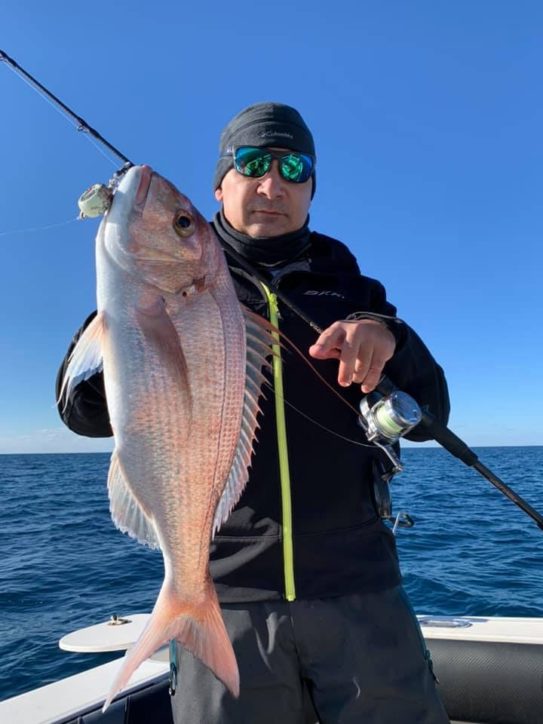
(Pink dentex caught with “Zoka Ball”. Photo © Saša Rakar)
I can’t help but mention new “Swimming Head” lures produced by Jigging Master, which are the “monster”-kabura for great depths. Unfortunately, I haven’t had time to test them yet, but our customers have already managed to catch several trophy groupers with them.
The “rubber jigging” tackle is simple and I would advise anglers who decide to go fishing with kabura and inchiku to buy specialized ones. However, rods designed for the “slow jigging” technique can be used for this technique as well. But not the other way around – it’s almost impossible to use rods designed for “rubber jigging” fishing and correctly animate “slow” jigs because these rods have fundamentally different systems. Rods for “slow jigging” have a system called “fast” or “extra fast”, rods for “rubber jigging” are close to “regular”.
Probably, someone will be able to talk about the issue more competently, but we talk based on my experience. I use the recommended tackle for certain techniques and experiment little with new combinations of rods and reels. However, when fishing with Zoka Ball, I use rods for vertical jigging as well, since large fish are often caught in a fairly limited period, and in this case, the speed of fish extraction is important to me.

(Pink dentex caught with “Zoka Ball”. Photo © Saša Rakar)
However, it would be too easy if you didn’t have to find, or in some other way choose, the right positions for fishing. After all, the high-quality tackle and lures that you bought are unlikely to catch fish in places where there is no fish.